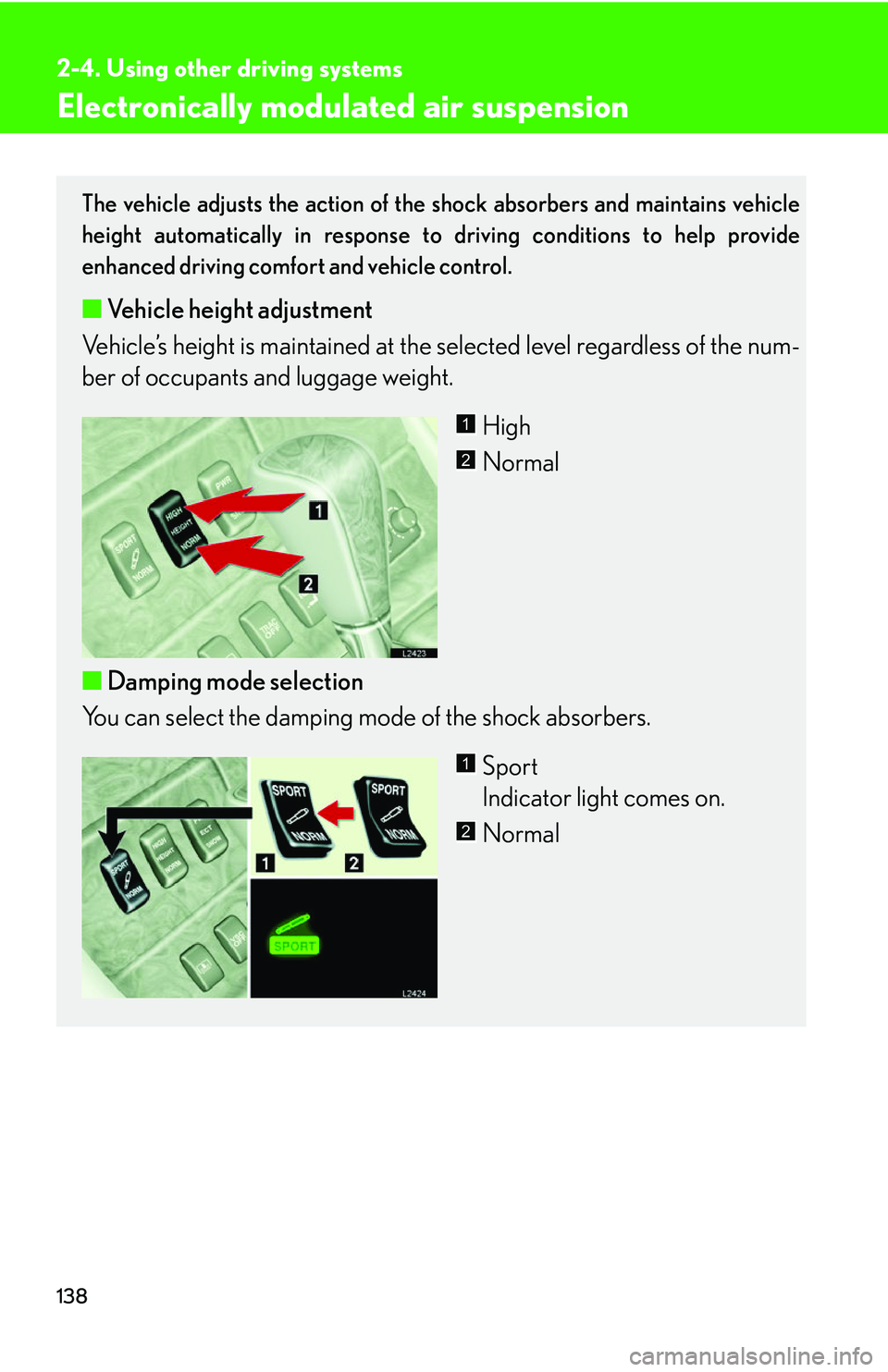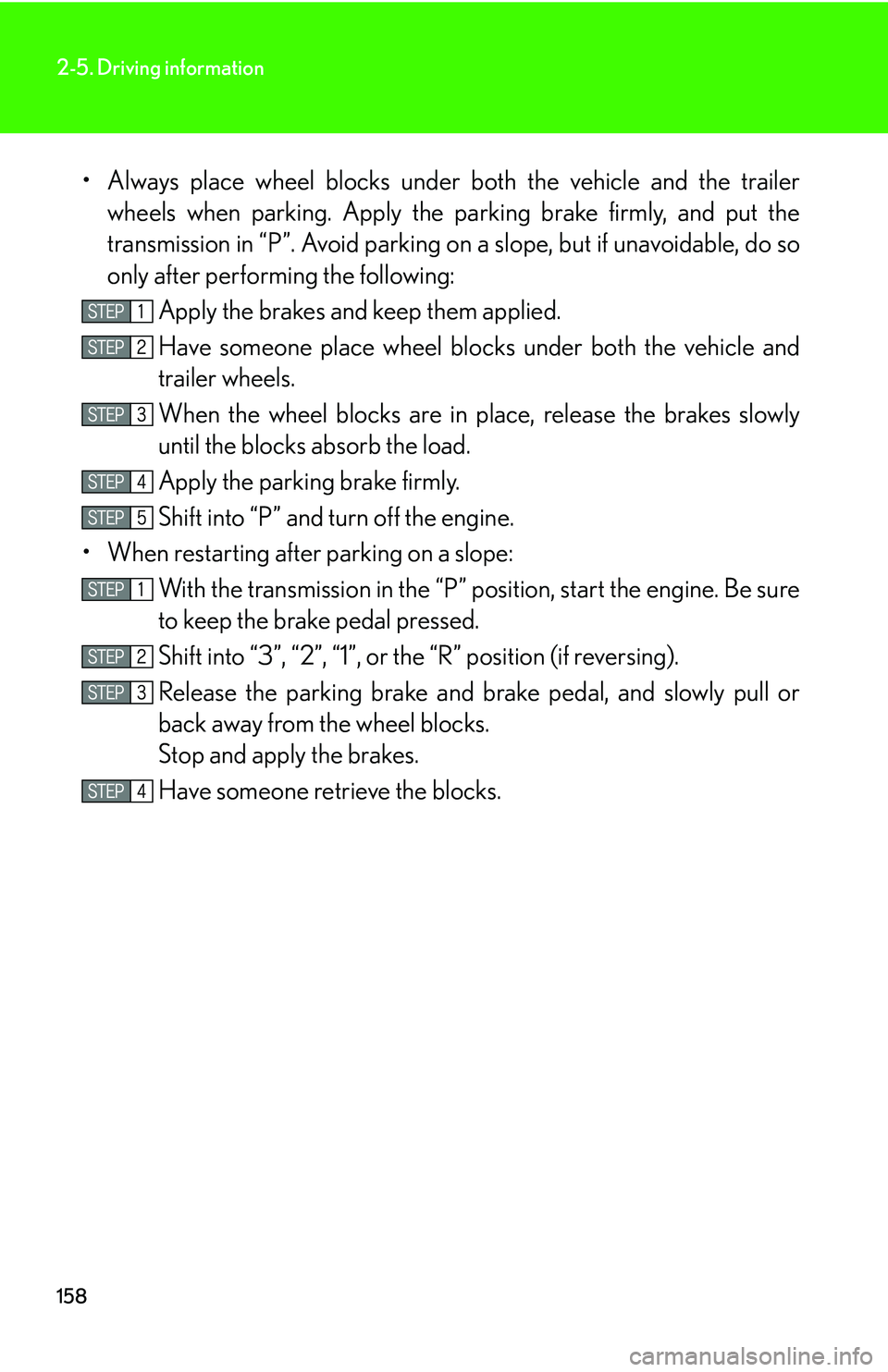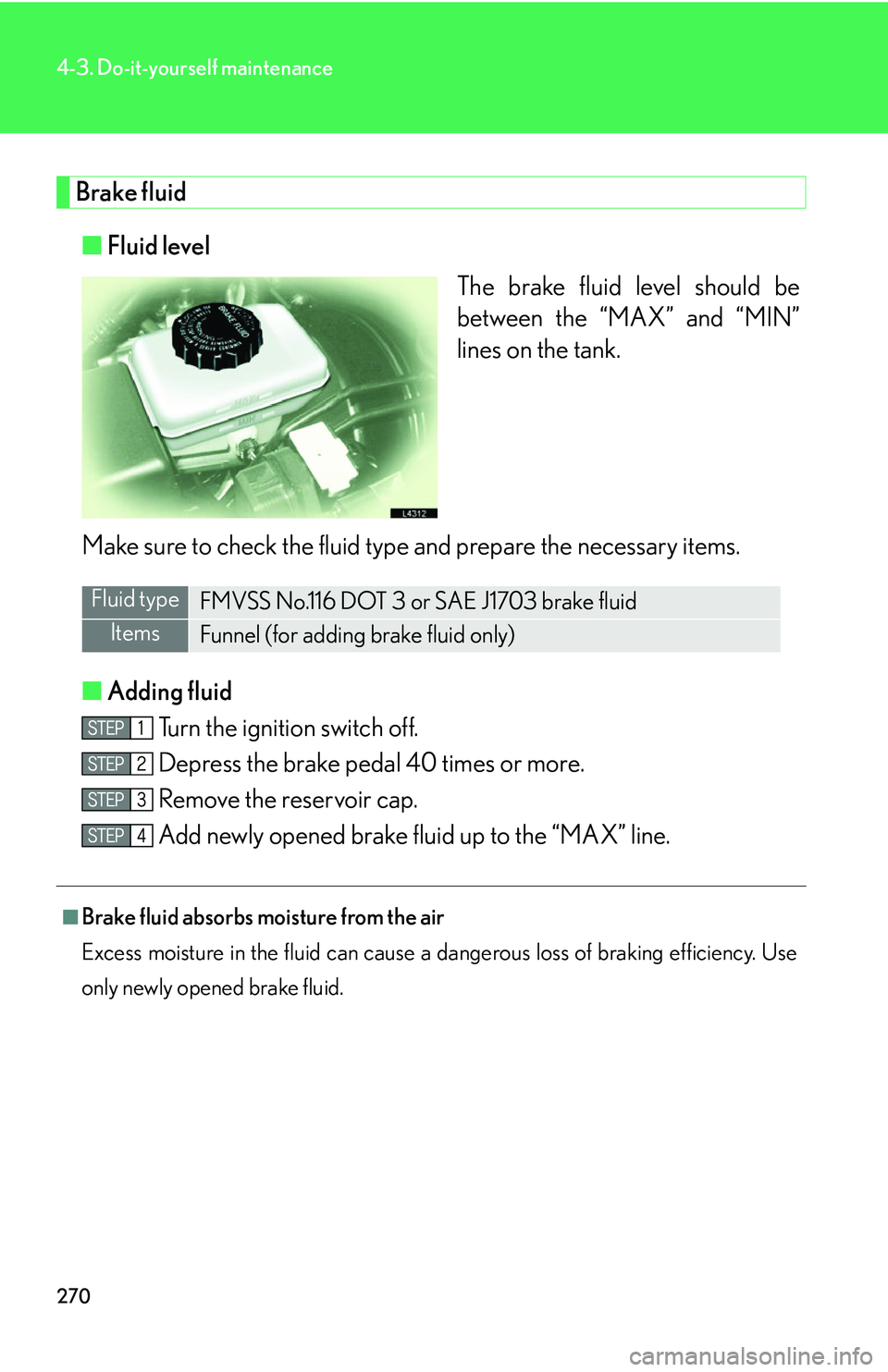ABS LEXUS LS430 2006 Owners Manual
[x] Cancel search | Manufacturer: LEXUS, Model Year: 2006, Model line: LS430, Model: LEXUS LS430 2006Pages: 419, PDF Size: 11.19 MB
Page 122 of 419

106
2-2. Instrument cluster
CAUTION
■If a safety system warning light does not come on
Should a safety system light such as ABS, TR
AC OFF or the airbag warning light
not come on when you start the engine, th is could mean that these systems are not
available to help protect you in an accident, which could result in death or serious
injury. Have the vehicle inspected by your Lexus dealer immediately if this occurs.
■ Warning lights
Warning lights inform the driver of a malfunction in the indicated vehi -
cle’s systems. (
P. 328 )
* These lights turn on when the ignition sw itch is turned to ON to indicate that
a system check is being performed. Th ey will turn off after the engine is
started on, or after a few seconds.
There may be a malfunction in a system if a
light does not come on, or if the
lights do not turn off. Have the vehicle inspected by your Lexus dealer.
*
(U.S.A)
(U.S.A) (Canada) (U.S.A) (Canada)
(Canada)
Page 137 of 419

121
2-4. Using other driving systems
2
When driving
■Objects which may not be detected
●Wires or ropes.
●Objects with a surface area too small to reflect ultrasonic waves such as a
chain-link fence.
●Sound wave absorbing objects such as cotton or snow.
●Objects with a sharp edge.
●Shorter objects.
●Tall objects with the upper part projected.
■Operating condition
The ignition switch must b
e turned to ON.
■Park assist graphics (vehicles equippe d with the Navigation system) System
The park assist graphics also appear on the n
avigation display. For details, see the
separate “Navigation System Owner’s Manual”.
■Certification for the Lexus park assist system (Canada)
This ISM device complies with Canadian ICES-001.
■Failure warnings
If a system error is detected, the master warning light comes on, 5 beeps sound, the
fo
llowing warning message appears, and gr aphic information indicates the faulty
sensor. ( P.334 )
■Customization
The volume of the beeps can be changed. ( P. 3 8 4 )
Page 154 of 419

138
2-4. Using other driving systems
Electronically modulated air suspension
The vehicle adjusts the action of the shock absorbers and maintains vehicle
height automatically in response to driving conditions to help provide
enhanced driving comfort and vehicle control.
■ Vehicle height adjustment
Vehicle’s height is maintained at the se lected le
vel regardless of the num-
ber of occupants and luggage weight.
High
Normal
■ D
amping mode selection
You can select the damping mo de of the shock absorbers.
Sport
Indicator light comes on.
Normal
1
2
1
2
Page 156 of 419

140
2-4. Using other driving systems
Driver assist systems
When VSC or TRAC is operating
If the vehicle is in danger of slip-
ping or the rear wheels spin, the
slip indicator ligh t flash to indicate
that the s
ystems have been
engaged.
A buzzer (intermittent) sounds
when VSC is operating.
To help enhance improve vehicle safety, the following systems operate auto-
matically in certain driving conditions.
■ ABS (Anti-lock Braking System)
Help ensure steering performance in th e event of sudden braking or driving
on slippery road surfaces.
■ BA (Brake Assist)
Generates an increased level of braking force after the brake pedal is
pushed, when the system detects a panic stop situation.
■VSC (Vehicle Stability Control)
Helps the driver to control skidding wh en swerving suddenly or turning on
slippery road surfaces.
■ TRAC (Traction Control)
Helps maintain drive power and prevents spinning the rear wheels when
starting the vehicle or accelerating on slippery roads.
■Pre-collision system (if equipped)
( P. 1 4 3 )
Page 157 of 419

141
2-4. Using other driving systems
2
When driving
To disable VSC and TRAC
If the vehicle gets stuck in fresh snow or mud, VSC and TRAC may
reduce power from the engine to the wheels. You may need to turn VSC
and TRAC off to enable you to rock the vehicle in order to free the vehi-
cle.
Push the button to turn off VSC
and TRAC.
The TRAC OFF indicator light
turns on.
Push the button again to turn the
sy
stem back on.
1
■Operating sounds and vibrations caus ed by the ABS, VSC & TRAC systems
●A sound may be heard from the engine compartment when the engine is
started or just after the vehicle begins to move. This sound does not indicate that
a malfunction has occurred in any of these systems.
●Any of the following conditions may occur when the ABS, VSC and TRAC sys -
tems are operating. None of these indicates that a malfunction has occurred.
• A sound may be heard.
• Vibrations may be felt through the vehicle body and steering.
• A motor sound may be heard after the vehicle comes to a stop.
• The brake pedal may pulsate slightly while the ABS is activated.
• The brake pedal may move forward slightly after the ABS is activated.
■Failure warning for VSC or TRAC system
If an error in the VSC or TRAC systems is
detected, the master warning light and
TRAC OFF indicator light comes on, a warning tone sounds. (P.334 )
Page 158 of 419

142
2-4. Using other driving systems
CAUTION
Any of the following conditions may result in-an accident which could cause death
or serious injury:
■The ABS may not operate effectively when:
●The limits of tire gripping performance have been exceeded.
●If the vehicle hydroplanes while driving at high speed while the road is wet or
slick.
■Stopping distance when the ABS is activated will exceed that of normal condi -
tions
The ABS is not designed to shorten the v
ehicle’s stopping distance. Always main -
tain a safe distance between you and the vehicle in front of you, particularly in the
fo
llowing situations.
• When driving on dirt, gravel or snow-covered roads
• When driving with tire chains
• When driving over bumps in the road
• When driving over roads with potholes or uneven roads
• When towing a trailer
■TRAC may not operate effectively when:
Directional control and power may not be ac hi
evable while driving on slippery road
surfaces, even if the TRAC system is operating.
Do not drive the vehicle in conditions where control and power may be lost.
■When the slip indicator flashe s and a warning buzzer sounds
This situation occurs immediately before VSC is activated. Always drive carefully.
R
eckless driving may cause an at the recommended level.
Exercise particular care when an indicator light flashes and a buzzer sounds.
■Replacing tires
Ensure that all tires are the same size an d
brand, have the same tread pattern, and
that the level of tire pressure is at the recommended level.
The ABS and VSC systems may not operate no rmal
ly if different tires are installed
to the vehicle.
Contact your Lexus dealer for further info rmati
on when replacing tires or wheels.
Page 159 of 419

143
2-4. Using other driving systems
2
When driving
Pre-collision system (if equipped)
■The pre-collision system may not operate effectively in the following situations:
●When traveling through a curve with objects on the edge of the road.
●When traveling through a curve with another vehicle passing in the opposite
direction.
●Narrow iron bridges.
●Metallic objects on the road.
●A steel plate on the road (e.g., at a construction site).
●When waiting to turn to the left in an in tersection with another vehicle passing in
the opposite direction.
●If your vehicle approaches another vehicle ahead very quickly.
The vehicle reacts to a frontal collision the instant before it happens using fol-
lowing components.
■ Pre-collision sensor
Uses the radar to detect possible obst acles ahead. Sensors then determine in
advance whether a crash is unavoidable.
■ Pre-collision seat belts (Front seat belts only)
Helps enhance their restraint performance by quickly retracting if an acci -
dent is calculated to be inevitable.
■ Pre-collision brake assist system
Once an accident is calculated to be inevitable, increased braking force will
be applied once the brake pedal is pressed.
■ Electronically modulated air suspension control
Once an accident is calculated to be inevitable, the vehicle adjusts the damp -
ing action of the shock absorbers to help keep the vehicle level.
Page 174 of 419

158
2-5. Driving information
• Always place wheel blocks under both the vehicle and the trailer
wheels when parking. Apply the pa rking brake firmly, and put the
transmission in “P”. Avoi d parking on a slope, but if unavoidable, do so
only after performing the following:
Apply the brakes and keep them applied.
Have someone place wheel blocks under both the v
ehicle and
trailer wheels.
When the wheel blocks are in pl ace, r
elease the brakes slowly
until the blocks absorb the load.
Apply the parking brake firmly.
Shift into “P” and turn off the engine.
• When restarting after parking on a slope:
With the transmission in the “P” position, star
t the engine. Be sure
to keep the brake pedal pressed.
Shift into “3”, “2”, “1”, or the “R” position (if r
eversing).
Release the parking brake and br ak
e pedal, and slowly pull or
back away from the wheel blocks.
Stop and apply the brakes.
Have someone retrieve the blocks.
Page 286 of 419

270
4-3. Do-it-yourself maintenance
Brake fluid
■Fluid level
The brake fluid level should be
betw
een the “MAX” and “MIN”
lines on the tank.
Make sure to check the fluid type and prepare the necessary items.
■ A
dding fluid
Turn the ignition switch off.
Depress the brake pedal 40 times or more.
Remove the reservoir cap.
Add newly opened brake fluid up to the “MAX” line.
Fluid typeFMVSS No.116 DOT 3 or SAE J1703 brake fluid
ItemsFunnel (for adding brake fluid only)
■Brake fluid absorbs moisture from the air
Excess moisture in the fluid can cause a dangerous loss of braking efficiency. Use
o
nly newly opened brake fluid.
Page 306 of 419

290
4-3. Do-it-yourself maintenance
Remove the filter case.
Remove the air conditioning filter
from the filter case and replace it with
a new one.The UP
marks shown on the filter
and the filter case should be point -
ing up.
Install the filter cover
Upper tabs
Lower tabs1
2